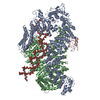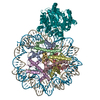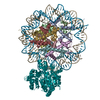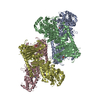[English] 日本語
 Yorodumi
Yorodumi- PDB-5zr1: Saccharomyces Cerevisiae Origin Recognition Complex Bound to a 72... -
+ Open data
Open data
- Basic information
Basic information
| Entry | Database: PDB / ID: 5zr1 | ||||||
|---|---|---|---|---|---|---|---|
| Title | Saccharomyces Cerevisiae Origin Recognition Complex Bound to a 72-bp Origin DNA containing ACS and B1 element | ||||||
 Components Components |
| ||||||
 Keywords Keywords | DNA BINDING PROTEIN/DNA / Origin Recognition Complex / DNA replication initiation / 72-bp origin DNA / DNA BINDING PROTEIN / DNA BINDING PROTEIN-DNA complex | ||||||
| Function / homology |  Function and homology information Function and homology informationCDC6 association with the ORC:origin complex / Cul8-RING ubiquitin ligase complex / maintenance of rDNA / Assembly of the ORC complex at the origin of replication / nuclear origin of replication recognition complex / pre-replicative complex assembly involved in nuclear cell cycle DNA replication / Activation of the pre-replicative complex / nuclear pre-replicative complex / nucleosome organization / DNA replication preinitiation complex ...CDC6 association with the ORC:origin complex / Cul8-RING ubiquitin ligase complex / maintenance of rDNA / Assembly of the ORC complex at the origin of replication / nuclear origin of replication recognition complex / pre-replicative complex assembly involved in nuclear cell cycle DNA replication / Activation of the pre-replicative complex / nuclear pre-replicative complex / nucleosome organization / DNA replication preinitiation complex / Activation of ATR in response to replication stress / mitotic DNA replication checkpoint signaling / silent mating-type cassette heterochromatin formation / Orc1 removal from chromatin / regulation of DNA replication / DNA replication origin binding / DNA replication initiation / subtelomeric heterochromatin formation / nucleosome binding / chromosome, telomeric region / chromatin binding / ATP hydrolysis activity / nucleoplasm / ATP binding / metal ion binding / nucleus Similarity search - Function | ||||||
| Biological species |  | ||||||
| Method | ELECTRON MICROSCOPY / single particle reconstruction / cryo EM / Resolution: 3 Å | ||||||
 Authors Authors | Li, N. / Lam, W.H. / Zhai, Y. / Cheng, J. / Cheng, E. / Zhao, Y. / Gao, N. / Tye, B.K. | ||||||
 Citation Citation |  Journal: Nature / Year: 2018 Journal: Nature / Year: 2018Title: Structure of the origin recognition complex bound to DNA replication origin. Authors: Ningning Li / Wai Hei Lam / Yuanliang Zhai / Jiaxuan Cheng / Erchao Cheng / Yongqian Zhao / Ning Gao / Bik-Kwoon Tye /   Abstract: The six-subunit origin recognition complex (ORC) binds to DNA to mark the site for the initiation of replication in eukaryotes. Here we report a 3 Å cryo-electron microscopy structure of the ...The six-subunit origin recognition complex (ORC) binds to DNA to mark the site for the initiation of replication in eukaryotes. Here we report a 3 Å cryo-electron microscopy structure of the Saccharomyces cerevisiae ORC bound to a 72-base-pair origin DNA sequence that contains the ARS consensus sequence (ACS) and the B1 element. The ORC encircles DNA through extensive interactions with both phosphate backbone and bases, and bends DNA at the ACS and B1 sites. Specific recognition of thymine residues in the ACS is carried out by a conserved basic amino acid motif of Orc1 in the minor groove, and by a species-specific helical insertion motif of Orc4 in the major groove. Moreover, similar insertions into major and minor grooves are also embedded in the B1 site by basic patch motifs from Orc2 and Orc5, respectively, to contact bases and to bend DNA. This work pinpoints a conserved role of ORC in modulating DNA structure to facilitate origin selection and helicase loading in eukaryotes. | ||||||
| History |
|
- Structure visualization
Structure visualization
| Movie |
 Movie viewer Movie viewer |
|---|---|
| Structure viewer | Molecule:  Molmil Molmil Jmol/JSmol Jmol/JSmol |
- Downloads & links
Downloads & links
- Download
Download
| PDBx/mmCIF format |  5zr1.cif.gz 5zr1.cif.gz | 525.7 KB | Display |  PDBx/mmCIF format PDBx/mmCIF format |
|---|---|---|---|---|
| PDB format |  pdb5zr1.ent.gz pdb5zr1.ent.gz | 406.6 KB | Display |  PDB format PDB format |
| PDBx/mmJSON format |  5zr1.json.gz 5zr1.json.gz | Tree view |  PDBx/mmJSON format PDBx/mmJSON format | |
| Others |  Other downloads Other downloads |
-Validation report
| Arichive directory |  https://data.pdbj.org/pub/pdb/validation_reports/zr/5zr1 https://data.pdbj.org/pub/pdb/validation_reports/zr/5zr1 ftp://data.pdbj.org/pub/pdb/validation_reports/zr/5zr1 ftp://data.pdbj.org/pub/pdb/validation_reports/zr/5zr1 | HTTPS FTP |
|---|
-Related structure data
| Related structure data |  6941MC  6942C  6943C M: map data used to model this data C: citing same article ( |
|---|---|
| Similar structure data |
- Links
Links
- Assembly
Assembly
| Deposited unit | 
|
|---|---|
| 1 |
|
- Components
Components
-Origin recognition complex subunit ... , 6 types, 6 molecules ABCDEF
| #1: Protein | Mass: 104546.164 Da / Num. of mol.: 1 Source method: isolated from a genetically manipulated source Source: (gene. exp.)  Strain: ATCC 204508 / S288c / Gene: ORC1, YML065W / Production host:  |
|---|---|
| #2: Protein | Mass: 71342.180 Da / Num. of mol.: 1 Source method: isolated from a genetically manipulated source Source: (gene. exp.)  Strain: ATCC 204508 / S288c / Gene: ORC2, RRR1, SIR5, YBR060C, YBR0523 / Production host:  |
| #3: Protein | Mass: 72161.766 Da / Num. of mol.: 1 Source method: isolated from a genetically manipulated source Source: (gene. exp.)  Strain: ATCC 204508 / S288c / Gene: ORC3, OAF1, OIF1, YLL004W, L1365 / Production host:  |
| #4: Protein | Mass: 60772.152 Da / Num. of mol.: 1 Source method: isolated from a genetically manipulated source Source: (gene. exp.)  Strain: ATCC 204508 / S288c / Gene: ORC4, YPR162C, P9325.5 / Production host:  |
| #5: Protein | Mass: 55347.168 Da / Num. of mol.: 1 Source method: isolated from a genetically manipulated source Source: (gene. exp.)  Strain: ATCC 204508 / S288c / Gene: ORC5, YNL261W, N0834 / Production host:  |
| #6: Protein | Mass: 50369.531 Da / Num. of mol.: 1 Source method: isolated from a genetically manipulated source Source: (gene. exp.)  Strain: ATCC 204508 / S288c / Gene: ORC6, AAP1, YHR118C / Production host:  |
-72bp-oring DNA, ACS305, ... , 2 types, 2 molecules GH
| #7: DNA chain | Mass: 22203.266 Da / Num. of mol.: 1 / Source method: obtained synthetically / Source: (synth.)  |
|---|---|
| #8: DNA chain | Mass: 22174.412 Da / Num. of mol.: 1 / Source method: obtained synthetically / Source: (synth.)  |
-Non-polymers , 2 types, 6 molecules 


| #9: Chemical | | #10: Chemical | |
|---|
-Experimental details
-Experiment
| Experiment | Method: ELECTRON MICROSCOPY |
|---|---|
| EM experiment | Aggregation state: PARTICLE / 3D reconstruction method: single particle reconstruction |
- Sample preparation
Sample preparation
| Component | Name: Saccharomyces Cerevisiae Origin Recognition Complex Bound to a 72-bp Origin DNA containing ACS and B1 element Type: COMPLEX Details: Saccharomyces Cerevisiae Origin Recognition Complex (Orc1-6, chain A-F) Bound to a 72-bp Origin DNA (a 72-bp dsDNA chain G-H) containing ACS and B1 element Entity ID: #1-#8 / Source: RECOMBINANT |
|---|---|
| Source (natural) | Organism:  |
| Source (recombinant) | Organism:  |
| Buffer solution | pH: 7.6 |
| Specimen | Embedding applied: NO / Shadowing applied: NO / Staining applied: NO / Vitrification applied: YES |
| Specimen support | Grid material: GOLD |
| Vitrification | Cryogen name: ETHANE |
- Electron microscopy imaging
Electron microscopy imaging
| Experimental equipment |  Model: Titan Krios / Image courtesy: FEI Company |
|---|---|
| Microscopy | Model: FEI TITAN KRIOS |
| Electron gun | Electron source:  FIELD EMISSION GUN / Accelerating voltage: 300 kV / Illumination mode: FLOOD BEAM FIELD EMISSION GUN / Accelerating voltage: 300 kV / Illumination mode: FLOOD BEAM |
| Electron lens | Mode: BRIGHT FIELD |
| Specimen holder | Cryogen: NITROGEN / Specimen holder model: FEI TITAN KRIOS AUTOGRID HOLDER |
| Image recording | Electron dose: 52.3 e/Å2 / Detector mode: SUPER-RESOLUTION / Film or detector model: GATAN K2 QUANTUM (4k x 4k) |
- Processing
Processing
| Software | Name: PHENIX / Version: 1.12_2829: / Classification: refinement | ||||||||||||||||||||||||
|---|---|---|---|---|---|---|---|---|---|---|---|---|---|---|---|---|---|---|---|---|---|---|---|---|---|
| CTF correction | Type: PHASE FLIPPING AND AMPLITUDE CORRECTION | ||||||||||||||||||||||||
| Symmetry | Point symmetry: C1 (asymmetric) | ||||||||||||||||||||||||
| 3D reconstruction | Resolution: 3 Å / Resolution method: FSC 0.143 CUT-OFF / Num. of particles: 164857 / Symmetry type: POINT | ||||||||||||||||||||||||
| Refine LS restraints |
|
 Movie
Movie Controller
Controller










 PDBj
PDBj











































